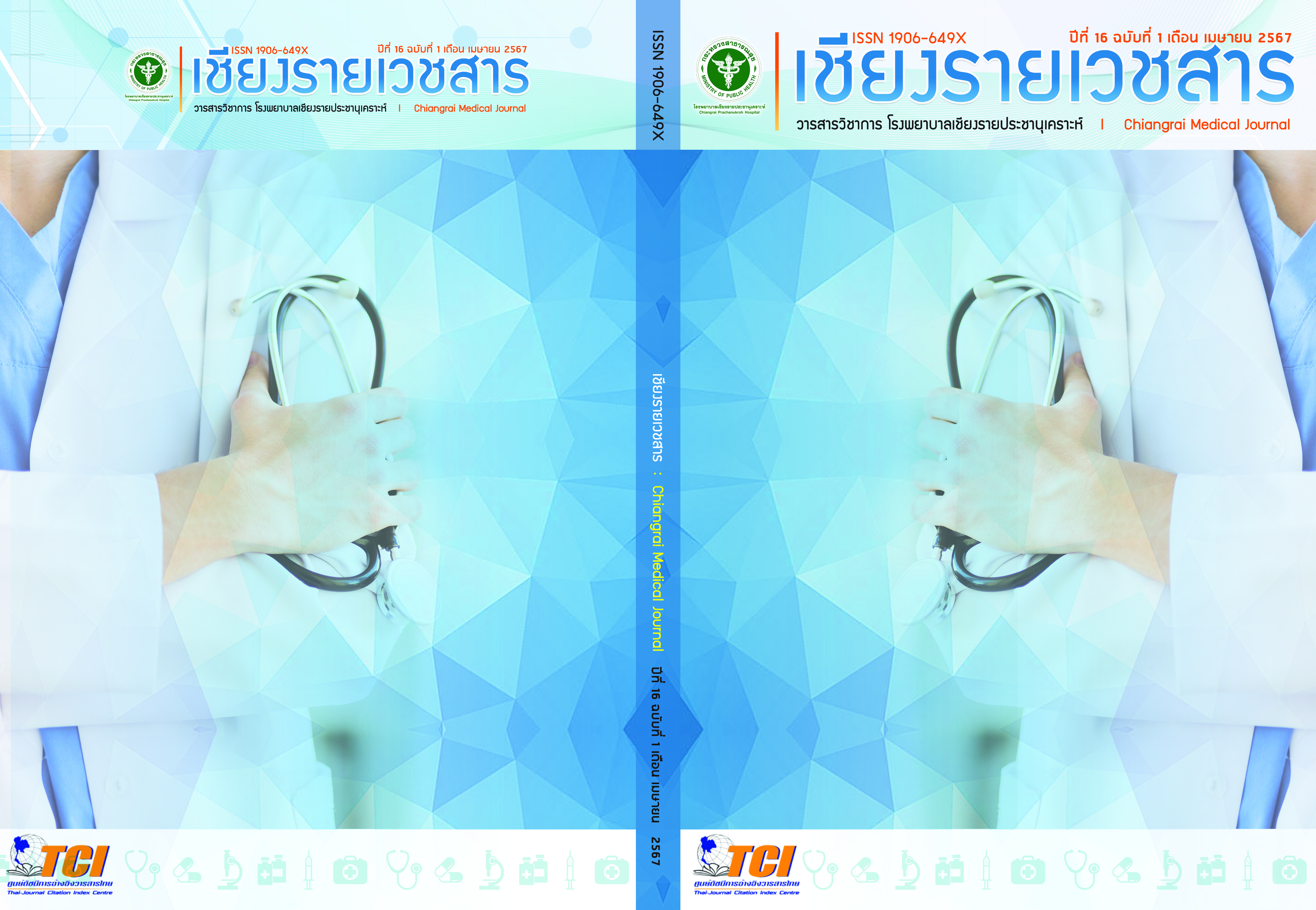ความแปรปรวนของระดับน้ำตาลหลังอดอาหารที่วัดในแต่ละครั้งของการมารับบริการที่โรงพยาบาลมีความสัมพันธ์กับการนอนโรงพยาบาลด้วยภาวะน้ำตาลต่ำหรือไม่: การศึกษาศูนย์เดียวในโรงพยาบาลเชียงรายประชานุเคราะห์ ประเทศไทย
Main Article Content
บทคัดย่อ
ความเป็นมา:การนอนโรงพยาบาลด้วยภาวะน้ำตาลต่ำเป็นภาวะแทรกซ้อนที่สำคัญอย่างหนึ่งที่อาจเกิดขึ้นได้ในการรักษาโรคเบาหวานชนิดที่ 2 แม้ว่าแนวปฏิบัติจากสมาคมโรคเบาหวานไทยไม่ได้กล่าวถึงการวัดความแปรปรวนของระดับน้ำตาล แต่ American Diabetes Association ในปี 2022 ได้กล่าวถึงความเกี่ยวโยงระหว่างความแปรปรวนของระดับน้ำตาลกับการเกิดภาวะน้ำตาลต่ำ และมีคำแนะนำตั้งเป้าหมายควบคุมความแปรปรวนของระดับน้ำตาลโดยใช้ค่าเปอร์เซ็นต์ของสัมประสิทธิ์ความแปรปรวน (%CV; percent coefficient of variation) ที่วัดจากเครื่อง continuous glucose monitor (CGM) ผู้วิจัยเกิดความสงสัยว่าระดับน้ำตาลหลังอดอาหารที่วัดเป็นครั้งๆ ในการมารับบริการอาจสามารถบ่งชี้ถึงการนอนโรงพยาบาลด้วยภาวะน้ำตาลต่ำ จึงได้ทำการศึกษาเพื่อพิสูจน์ความเกี่ยวข้องนี้
วัตถุประสงค์:เพื่อพิสูจน์ความสัมพันธ์ระหว่างความแปรปรวนของระดับน้ำตาลหลังอดอาหารในแต่ละครั้งของการมารับบริการกับการนอนโรงพยาบาลด้วยภาวะน้ำตาลต่ำ
วิธีการศึกษา:งานวิจัยแบบศึกษาตามรุ่นย้อนหลัง (retrospective cohort) ในประชากรผู้ใหญ่ที่ป่วยด้วยโรคเบาหวานชนิดที่ 2 และได้มารับบริการที่โรงพยาบาลเชียงรายประชานุเคราะห์ในปี พ.ศ. 2562 ถึง พ.ศ. 2564 รวมทั้งหมด 15,039 คน เหลือเข้าสู่การวิเคราะห์ 9,239 คน หลังการคัดออก วัดความแปรปรวนของระดับน้ำตาลหลังอดอาหารด้วยค่าสัมประสิทธิ์ความแปรปรวน (CV-FBS) โดยคำนวณจากค่าระดับน้ำตาลหลังอดอาหาร 3 ค่าที่สุ่มปีละ 1 ค่าใน 3 ปีด้วยคอมพิวเตอร์ แบ่งกลุ่มผู้ป่วยออกเป็น 4 กลุ่มตามควาร์ไทล์ของ CV-FBS ทำการคำนวณ Kaplan-Meier curves, Log-rank test และ Cox proportional hazard regression
ผลการศึกษา:ควาร์ไทล์ที่ 1 มี CV-FBS 0.00 - 0.06 หรือ 0.00% - 5.89% ควาร์ไทล์ที่ 2 มี CV-FBS 0.06 - 0.11 หรือ 5.89% - 10.54% ควาร์ไทล์ที่ 3 มี CV-FBS 0.11 - 0.18 หรือ 10.54% - 18.35% ควาร์ไทล์ที่ 4 มี CV-FBS 0.18 - 0.89 หรือ 18.37% - 89.37% ได้ทำ Kaplan-Meier curves แสดงถึงโอกาสการนอนโรงพยาบาลด้วยภาวะน้ำตาลต่ำที่สูงขึ้นในควาร์ไทล์ที่สูงขึ้น Log-rank test พบ p-value <0.001 เมื่อเทียบกับควาร์ไทล์ที่ 1 แล้ว พบว่าควาร์ไทล์ที่ 2 มีค่า hazard ratio เท่ากับ 1.36 (p-value 0.229; 95%CI 0.82 - 2.25) ควาร์ไทล์ที่ 3 มีค่า hazard ratio เท่ากับ 1.87 (p-value 0.008; 95%CI 1.17 - 2.97) และควาร์ไทล์ที่ 4 มีค่า hazard ratio เท่ากับ 2.82 (p-value <0.001; 95%CI 1.78 - 4.46) ฉะนั้น ความแปรปรวนของระดับน้ำตาลหลังอดอาหารมีผลเพิ่มโอกาสการนอนโรงพยาบาลด้วยภาวะน้ำตาลต่ำอย่างมีนัยสำคัญในควาร์ไทล์ที่ 3 และควาร์ไทล์ที่ 4
สรุปและข้อเสนอแนะ:ความแปรปรวนของระดับน้ำตาลหลังอดอาหารในแต่ละครั้งของการมารับบริการมีความสัมพันธ์กับการนอนโรงพยาบาลด้วยภาวะน้ำตาลต่ำ โดยค่า CV-FBS สูงตั้งแต่ 0.11 หรือ 10.54% ขึ้นไปควรถือว่าเป็นปัจจัยเสี่ยงหนึ่งของการเกิดภาวะน้ำตาลต่ำ
Article Details

อนุญาตภายใต้เงื่อนไข Creative Commons Attribution-NonCommercial-NoDerivatives 4.0 International License.
เอกสารอ้างอิง
Diabetes Association of Thailand. Medical practice guidelines for diabetes. Bangkok: Sri Muang Printing;2023.
American Diabetes Association. Statistics about diabetes [Internet]. [cited 2024 Jan 1]. Available from: https://www.diabetes.org/about-us/statistics/about-diabetes
Seaquist ER, Anderson J, Childs B, Cryer P, Dagogo-Jack S, Fish L, et al. Hypoglycemia and diabetes: a report of a workgroup of the American Diabetes Association and the Endocrine Society. J Clin Endocrinol Metab. 2013 ;98(5):1845-59.
Nakhleh A, Shehadeh N. Hypoglycemia in diabetes: An update on pathophysiology, treatment, and prevention. World J Diabetes. 2021;12(12):2036-49.
McCoy RG, Van Houten HK, Ziegenfuss JY, Shah ND, Wermers RA, Smith SA. Increased mortality of patients with diabetes reporting severe hypoglycemia. Diabetes Care. 2012;35(9):1897-901.
Cryer PE, Davis SN, Shamoon H. Hypoglycemia in diabetes. Diabetes Care. 2003;26(6):1902-12.
Sacks DB, Arnold M, Bakris GL, Bruns DE, Horvath AR, Kirkman MS, Lernmark A, Metzger BE, Nathan DM. Guidelines and recommendations for laboratory analysis in the diagnosis and management of diabetes mellitus. Clin Chem. 2011;57(6):e1-e47
Ceriello A, Esposito K, Piconi L, Ihnat MA, Thorpe JE, Testa R, et al. Oscillating glucose is more deleterious to endothelial function and oxidative stress than mean glucose in normal and type 2 diabetic patients. Diabetes. 2008;57(5):1349-54.
American Diabetes Association Professional Practice Committee. 6. Glycemic targets: standards of medical care in diabetes-2022. Diabetes Care. 2022;45(Suppl 1):S83-S96.
Long C, Tang Y, Huang J, Liu S, Xing Z. Association of long-term visit-to-visit variability of HbA1c and fasting glycemia with hypoglycemia in type 2 diabetes mellitus. Front Endocrinol (Lausanne). 2022;13:975468.
DeVries JH, Bailey TS, Bhargava A, Gerety G, Gumprecht J, Heller S, et al. Day-to-day fasting self-monitored blood glucose variability is associated with risk of hypoglycaemia in insulin-treated patients with type 1 and type 2 diabetes: A post hoc analysis of the SWITCH Trials. Diabetes Obes Metab. 2019;21(3):622-30.
Zinman B, Marso SP, Poulter NR, Emerson SS, Pieber TR, Pratley RE, et al. Day-to-day fasting glycaemic variability in DEVOTE: associations with severe hypoglycaemia and cardiovascular outcomes (DEVOTE 2). Diabetologia. 2018;61(1):48-57.
Hirakawa Y, Arima H, Zoungas S, Ninomiya T, Cooper M, Hamet P, et al. Impact of visit-to-visit glycemic variability on the risks of macrovascular and microvascular events and all-cause mortality in type 2 diabetes: the ADVANCE trial. Diabetes Care. 2014;37(8):2359-65.
Corathers SD, Peavie S, Salehi M. Complications of diabetes therapy. Endocrinol Metab Clin North Am. 2013;42(4):947-70
Pongplanchai N, Ammatatrakul N, Banjerdsin N, Tanetsakulmatana N, Karnjanaungkoo A, Chimplee K. Risk Factors of Severe Hypoglycemia in Type 2 Diabetic Patients at District Hospital, Wiang Pa Pao Chiang Rai, Thailand. Greater Mekong Subregion Medical Journal. 2022;2(2):101-8.
Matsuhisa M, Kuroda A. New risk factors of severe hypoglycemia. New risk factors of severe hypoglycemia. J Diabetes Investig. 2019;10(2):219-20
Hendrieckx C, Halliday JA, Beeney LJ, Speight J. Diabetes and emotional health: a practical guide for health professionals supporting adults with type 1 or type 2 diabetes. 3rd ed. Arlington, VA: American Diabetes Association, 2021.
Buse JB, Gerstein HC, Probstfield J, Grimm RH, Ismail-Beigi F, Bigger JT, et al. Effects of combination lipid therapy in type 2 diabetes mellitus. N Engl J Med. 2010;362(17):1563-74.
Wang A, Liu X, Xu J, Han X, Su Z, Chen S, et al. Visit-to-Visit Variability of Fasting Plasma Glucose and the Risk of Cardiovascular Disease and All-Cause Mortality in the General Population. J Am Heart Assoc. 2017;6(12):e006757.
An HM, Yeo SH, Chung HJ, Cho HS, Bae SJ, Kim JY, et al. Visit-to-visit changes in fasting blood sugar and the risk for cardiovascular disease and mortality in the Korean population: a nationwide population-based cohort study. Eur Rev Med Pharmacol Sci. 2021;25(1):263-72.
Lin CC, Yang CP, Li CI, Liu CS, Chen CC, Lin WY, et al. Visit-to-visit variability of fasting plasma glucose as predictor of ischemic stroke: competing risk analysis in a national cohort of Taiwan Diabetes Study. BMC Med. 2014;12:165.


